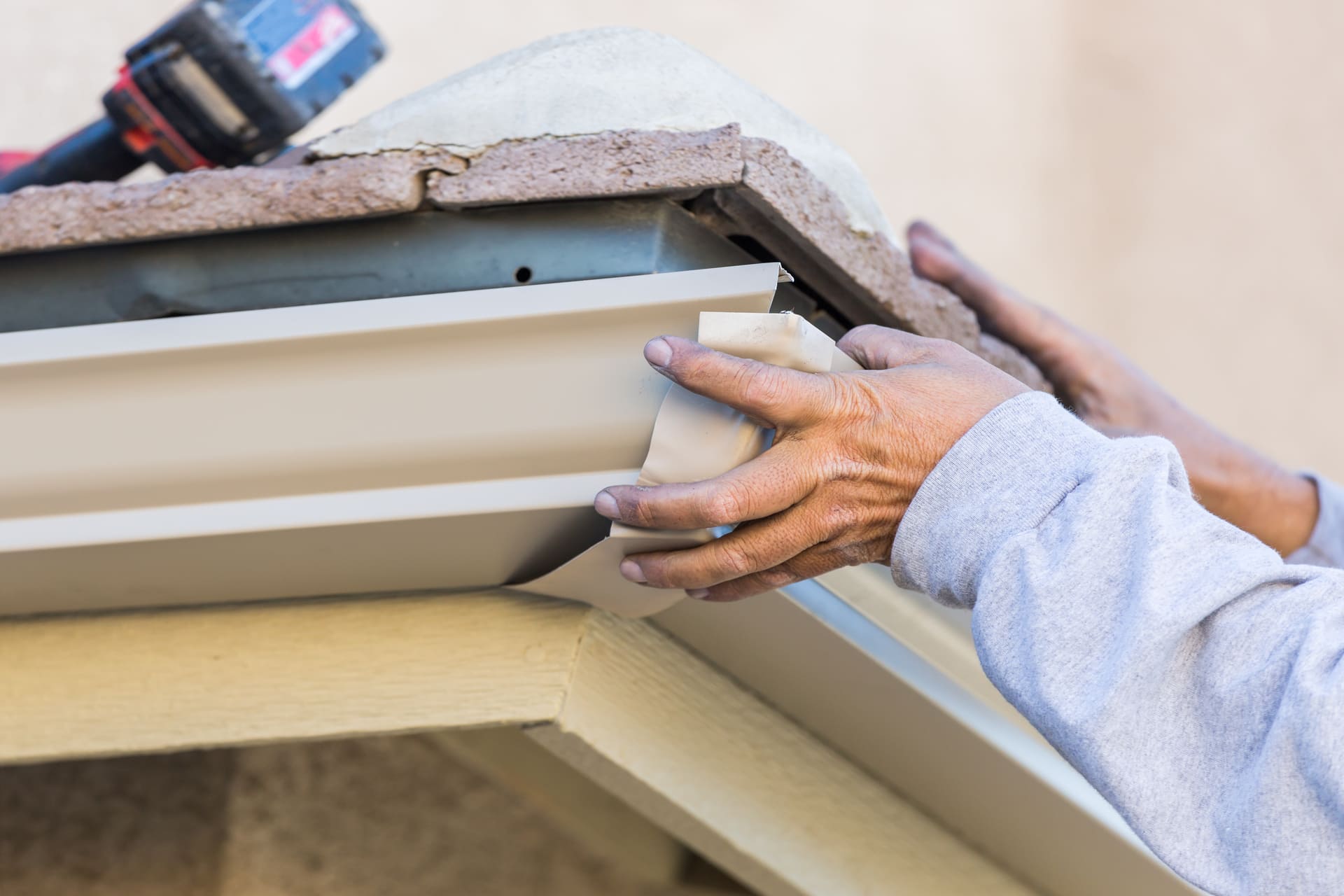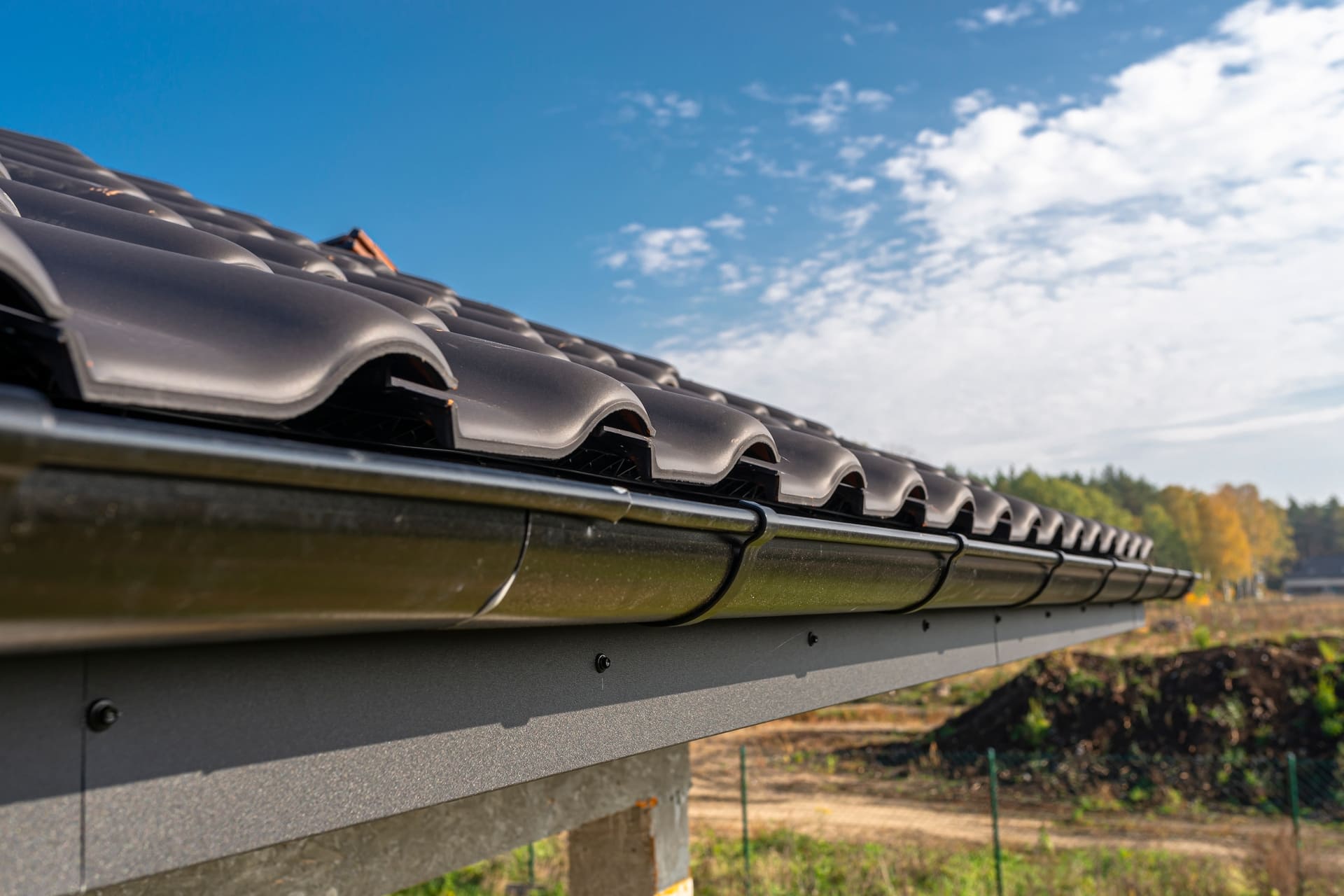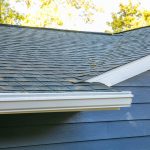
Wisconsin’s weather puts your gutters to the test year after year. Between freezing winters, heavy rains, and spring thaw, even durable systems eventually wear down.
Cracks, rust, or sagging sections might seem minor, but if left too long, they can lead to foundation damage, rotted siding, or ice dams that compromise your roof. Most gutters last 10 to 40 years, depending on the material and maintenance.
At Prairie Exteriors, we help Wisconsin homeowners recognize these warning signs before costly water damage occurs, ensuring your home stays protected through our state’s demanding seasonal cycles.
Prairie Exteriors’ experienced team provides comprehensive gutter repair services in Madison, WI, tailored to Wisconsin’s unique climate demands.
How Long Do Gutters Last in Wisconsin?
The lifespan of gutters in Wisconsin depends on material quality, installation, and exposure to our state’s harsh climate. Most systems last 10–40 years, depending on upkeep and material choice:
- Vinyl gutters (10–15 years): The most affordable option, but not ideal for Wisconsin’s cold winters. Vinyl becomes brittle in sub-zero temperatures and can crack under ice buildup.
- Aluminum gutters (20–30 years): Lightweight, rust-resistant, and well-suited for the state’s freeze-thaw cycles. A popular balance of cost, performance, and longevity for most Wisconsin homes.
- Steel gutters (25–40 years): Heavy-duty and durable, perfect for areas with frequent snow and ice dams. However, they need consistent maintenance to prevent rust in Wisconsin’s moisture-heavy climate.
- Copper gutters (40+ years): The most durable and visually appealing option, with natural corrosion resistance that stands up to decades of weather. While more expensive upfront, copper gutters can last a lifetime with minimal maintenance.
When choosing a replacement material, consider local weather conditions, roofline design, budget, and desired curb appeal. Heavier materials like steel or copper offer exceptional longevity, while aluminum remains the go-to choice for reliable performance at a lower cost.
Additional reading: how long do gutters last
| Gutter Material | Average Lifespan in Wisconsin | Climate Considerations |
| Vinyl | 10-15 years | Brittleness in extreme cold, UV damage |
| Aluminum | 20-30 years | Excellent freeze-thaw resistance |
| Steel | 25-40 years | Superior strength, requires rust prevention |
| Copper | 50+ years | Premium durability, develops protective patina |
Key Warning Signs Your Gutters Need Replacement
Recognizing early warning signs prevents costly water damage and protects your home’s foundation, siding, and structural integrity. Wisconsin’s extreme weather accelerates gutter deterioration, making regular inspections essential for maintaining your home’s protection.
Visible Structural Damage
- Cracks and splits represent the most obvious replacement indicators. Small cracks may seem manageable, but Wisconsin’s freeze-thaw cycles cause rapid expansion. Water enters these cracks, freezes overnight, and widens the damage significantly by spring.
- Sagging sections indicate failed mounting systems or excessive weight from ice and debris. When gutters pull away from fascia boards, they can no longer direct water effectively, leading to foundation pooling and basement flooding risks.
- Rust spots and corrosion signal material breakdown, especially common on older steel systems. Once rust penetrates the protective coating, deterioration accelerates rapidly in Wisconsin’s humid conditions.
Water Management Failures
- Overflowing gutters during moderate rainfall suggest capacity issues or blockages that cleaning cannot resolve. In Wisconsin, this often indicates systems undersized for our heavy spring snowmelt and intense summer storms.
- Foundation pooling around your home’s perimeter shows gutters aren’t directing water away effectively. This creates serious risks, including basement flooding, foundation cracks, and soil erosion around your property.
- Water stains on siding or soffit areas indicate leaking joints or overflow problems. These stains often appear after Wisconsin’s harsh winters when ice damage becomes visible.
Performance Issues Beyond Repair
- Frequent maintenance needs suggest system-wide problems rather than isolated issues. If you’re constantly repairing loose fasteners, resealing joints, or unclogging the same sections, replacement becomes more cost-effective than ongoing repairs.
- Ice dam formation along gutter lines indicates inadequate water flow and potential capacity problems. Wisconsin homeowners frequently experience this issue when gutters can’t handle rapid snowmelt during temperature fluctuations.
Wisconsin Climate Factors That Affect Gutter Replacement Timing
Wisconsin’s distinct four-season climate creates specific challenges that accelerate gutter wear and influence optimal replacement timing. These factors help homeowners plan proactively rather than react to emergency failures during harsh weather periods.
Winter Weather Impact
- Heavy snow loads stress mounting systems and can bend or detach gutters from fascia boards. According to the Wisconsin State Climatology Office, snowfall varies from about 30 inches annually in southern Wisconsin to more than 100 inches in areas receiving Lake Superior lake-effect snow.
- Ice dam formation occurs when inadequate gutter systems allow water backup and freezing along the roof edges. This phenomenon damages both gutters and roofing materials, often requiring emergency repairs during Wisconsin’s coldest months.
- Freeze-thaw cycles expand and contract gutter materials repeatedly throughout winter and spring. This constant movement loosens fasteners, opens seams, and creates the micro-cracks that develop into major failures.
Seasonal Water Management Demands

- Spring snowmelt produces Wisconsin’s heaviest water flow periods, often overwhelming inadequate gutter systems. Rapid temperature changes can dump weeks of accumulated snow into gutters within days.
- Summer storm intensity brings sudden, heavy downpours that test gutter capacity limits. Wisconsin’s thunderstorms frequently produce rainfall rates exceeding what older or undersized systems can handle effectively.
- Fall debris accumulation from Wisconsin’s abundant maple, oak, and ash trees creates blockages that prevent proper drainage. Clogged systems freeze solid during winter, causing expansion damage and spring overflow problems.
Prairie Exteriors provides comprehensive maintenance services that keep your gutter system performing optimally throughout Wisconsin's demanding seasonal cycles.
Best Times to Replace Gutters in Wisconsin
Timing your gutter replacement correctly ensures optimal installation conditions, better material performance, and contractor availability. Wisconsin’s seasonal variations create distinct advantages and disadvantages for replacement projects throughout the year.
Spring Installation Benefits
Early spring (April-May) offers ideal conditions after winter damage assessment but before heavy spring rains begin. Snow has melted, revealing winter damage, while temperatures remain moderate for optimal sealant curing and material handling.
Contractor availability improves significantly in the spring compared to peak summer demand. This timing allows more scheduling flexibility and potentially better pricing before the busy season begins.
Fall Installation Advantages
Fall timing (September-October) provides perhaps the best overall conditions for gutter replacement in Wisconsin. Temperatures remain moderate, humidity levels drop, and precipitation typically decreases compared to spring months.
Pre-winter preparation ensures your home has maximum protection before harsh weather arrives. New gutters provide better ice dam prevention and handle heavy snow loads more effectively than aging systems.
Emergency Replacement Situations
Immediate replacement becomes necessary regardless of season when gutters pose active threats to your home’s structural integrity. These situations include complete detachment, major storm damage, or active basement flooding from gutter failures.
Winter installation remains possible for emergencies, though material limitations and weather delays may affect project timelines. Professional contractors can work safely in winter conditions when home protection cannot wait for ideal weather.
📌 Wisconsin homeowners face unique challenges with snow, ice, and seasonal temperature swings. At Prairie Exteriors, we understand how timing, materials, and local conditions all come together for a lasting gutter system that keeps your home protected year after year.
Material Selection for Wisconsin Conditions
Choosing appropriate gutter materials significantly impacts longevity and performance in Wisconsin’s challenging climate. Each material offers distinct advantages and limitations that Wisconsin homeowners should consider before making replacement decisions.
Aluminum: The Wisconsin Standard
Seamless aluminum gutters represent the most popular choice among Wisconsin homeowners due to their excellent balance of durability, cost-effectiveness, and climate resistance. They handle freeze-thaw cycles without becoming brittle and resist corrosion from road salt and humidity.
Gauge thickness matters significantly in Wisconsin installations. Heavy-gauge (.032 inch) aluminum provides superior strength for snow loads and wind resistance compared to standard residential gauges.

Steel: Maximum Durability
Galvanized steel gutters offer exceptional strength for areas with heavy snow loads or frequent ice dam formation. They resist denting from falling ice or branches and support heavier debris loads without sagging.
Corrosion protection requires attention in Wisconsin’s humid climate and road salt exposure. Regular maintenance and prompt touch-up painting prevent rust penetration that leads to system failure.
Vinyl: Budget-Conscious Choice
Vinyl systems provide the most affordable upfront costs but require realistic expectations about Wisconsin performance. They work best in protected locations with minimal temperature extremes and moderate snow loads.
Cold weather limitations make vinyl unsuitable for exposed locations or homes in northern Wisconsin where temperatures regularly drop below -10°F. Brittle failures increase significantly in extreme cold conditions.
Copper: Long-term investment
Copper gutters offer unmatched durability and aesthetic appeal. With proper installation, they can last 40 years or more while naturally resisting corrosion and temperature fluctuations. Over time, copper develops a protective patina that adds character and further shields against rust.
Though more expensive upfront, copper is ideal for homeowners seeking a low-maintenance, lifetime solution that complements high-end or historic Wisconsin homes.
📌 At Prairie Exteriors, honesty and integrity guide every recommendation we make. We only install gutter systems that deliver lasting value and a true return on investment for Wisconsin homeowners. Our goal is simple — to provide solutions that stand up to our state’s demanding climate while protecting your home for years to come.
Contact our experts at your earliest convenience for tailored advice and solutions for your home.
Professional vs. DIY Gutter Replacement in Wisconsin
Wisconsin’s challenging installation conditions and building code requirements make professional installation advantageous for most homeowners. Safety concerns, material handling, and proper system design require expertise that ensures long-term performance and warranty protection.
Safety Considerations
Multi-story installations present significant risks, especially during Wisconsin’s unpredictable weather conditions. Professional contractors use specialized equipment and safety protocols that protect both workers and property during installation.
Winter accessibility creates additional hazards when emergency replacements become necessary. Ice, snow, and frozen conditions make DIY installations particularly dangerous and often impossible for homeowners.
Technical Installation Requirements
Proper slope calculation ensures effective drainage while preventing standing water that freezes and damages systems. Professional installers know regional drainage requirements and local building codes specific to Wisconsin installations.
Fascia board assessment identifies underlying structural issues that DIY installers often miss. Professional evaluation prevents installation failures when mounting surfaces require repair or reinforcement.
Seamless gutter fabrication requires specialized equipment unavailable to homeowners. Custom-fitted seamless systems eliminate leak-prone joints and provide superior performance in Wisconsin’s demanding climate.
Code Compliance and Permits
Local building codes in Wisconsin municipalities may require permits for gutter replacement, particularly when structural modifications become necessary. The Wisconsin Department of Safety and Professional Services oversees building code enforcement, and professional contractors handle permit applications and compliance requirements.
📌 At Prairie Exteriors & Painting, we combine decades of hands-on experience with a commitment to craftsmanship and customer care. Our team understands the complexities of Wisconsin’s building codes, weather patterns, and home construction, ensuring every gutter replacement is done safely, efficiently, and to the highest standards.
Cost Factors and Investment Considerations
Gutter replacement costs help Wisconsin homeowners budget appropriately and make informed decisions about material selection, timing, and installation scope. Regional factors significantly influence pricing throughout south-central Wisconsin.
Material Cost Variations
- Aluminum systems typically cost $8–15 per linear foot installed, including seamless fabrication and professional installation. Heavy-gauge options add to the price but deliver longer-lasting performance in Wisconsin’s climate.
- Steel installations range from $12–20 per linear foot due to higher material costs and specialized mounting requirements. The investment pays off for homes exposed to heavy snow, ice, or strong winds.
- Copper systems represent a premium choice at $25–40 per linear foot or more, depending on design and craftsmanship. While expensive upfront, copper offers unmatched longevity—often exceeding 40 years—with minimal maintenance and enduring curb appeal.
- Vinyl systems offer the lowest upfront cost at $4–8 per linear foot, but they may need more frequent replacement in Wisconsin’s extreme temperatures, potentially increasing long-term expenses.
Long-Term Value Analysis
Energy efficiency improvements from proper gutter installation reduce heating costs by preventing ice dams and moisture infiltration that compromise insulation effectiveness.
Property value protection through effective water management prevents costly foundation repairs, basement flooding, and structural damage that can significantly impact home values.
📌With over 60 years of combined experience in roofing, siding, and exterior improvements, we deliver results that not only protect your home but also enhance its value for years to come.
Maintenance to Extend Gutter Lifespan
Proper maintenance significantly extends gutter life in Wisconsin’s challenging climate while preventing premature replacement needs. Regular care protects your investment and maintains optimal performance during critical weather periods.
Seasonal Maintenance Schedule
Following a simple seasonal schedule keeps your system working efficiently and extends its lifespan.
- Spring cleaning removes winter debris and allows inspection for any ice or snow damage. Early cleaning also prevents blockages during heavy spring rains and snowmelt.
- Summer monitoring helps ensure proper water flow during storms. Clearing out growing vegetation and checking for sagging or loose fasteners prevents mid-season leaks.
- Fall preparation includes a thorough cleaning before leaf drop and the first freeze. This timing helps prevent ice buildup, overflow, and damage during early winter storms.
- Winter inspection focuses on spotting ice dams, downspout blockages, and areas where snow or ice may strain the system. Even a brief midwinter check can prevent costly repairs come spring.
Preventive Care Strategies
Regular maintenance plays a major role in extending the life of your gutters—especially in Wisconsin, where snow, ice, and falling leaves can quickly take their toll. A few proactive steps can help homeowners avoid costly repairs and keep their systems performing year-round.
Gutter guards help reduce maintenance while protecting against Wisconsin’s heavy leaf fall and debris buildup. They prevent most blockages but still require seasonal inspection, especially after fall or spring storms. Investing in high-quality mesh or surface-tension guards can extend gutter lifespan by minimizing rust and ice dam formation.
Proper landscaping around downspouts ensures water drains safely away from your foundation. Grading soil to slope outward and adding splash blocks or extensions helps prevent erosion and basement moisture issues. Strategic plant placement also reduces debris sources near gutters and minimizes clogging from overhanging branches.
Routine inspections and cleaning every spring and fall are essential for Wisconsin homeowners. Checking seams, fasteners, and slope alignment helps catch small issues before they lead to leaks or structural damage. Scheduling a professional cleaning once a year keeps your system performing at its best.
Protecting Your Wisconsin Home Investment
Your home’s gutters are more than a finishing touch — they’re a critical defense against Wisconsin’s unpredictable weather. From Lake Michigan’s lake-effect snow to the Mississippi River valley’s heavy storms, every home faces unique challenges. Quality materials, expert installation, and regular upkeep are essential to keeping your property protected.
Routine inspections and timely replacement prevent costly foundation damage, roof leaks, and structural issues caused by overflowing or frozen gutters. Investing in professional care today helps you avoid expensive repairs tomorrow.
At Prairie Exteriors & Painting, we bring decades of experience, craftsmanship, and integrity to every project. Our gutter systems are designed specifically for Wisconsin’s climate — durable, efficient, and built to protect your home year after year. When it’s time to replace your gutters, trust Prairie Exteriors to deliver results that last.
Contact us online or call +1 (608) 370-2528 today for a gutter inspection and keep your Wisconsin home protected.
FAQs
How much does gutter replacement cost in Madison and Sun Prairie, Wisconsin?
Gutter replacement costs in south-central Wisconsin typically range from $8-$20 per linear foot, depending on material choice and installation complexity. Aluminum systems cost $8- $15 per linear foot, while premium steel installations range $12- $20 per linear foot. Total project costs for average Wisconsin homes typically fall between $1,200- $3,500, including professional installation, permits, and material transportation costs.
What are the signs that my gutters are failing in Wisconsin’s climate?
Wisconsin gutters show failure through visible cracks that worsen during freeze-thaw cycles, sagging sections from ice weight, rust spots on steel systems, and water pooling around your foundation after storms. Overflowing gutters during moderate rainfall indicate capacity problems, while frequent ice dam formation suggests inadequate water flow for Wisconsin’s snowmelt conditions.
When is the best time to replace gutters in Wisconsin?
Early spring (April-May) and fall (September-October) provide optimal gutter replacement conditions in Wisconsin. Spring offers moderate temperatures after winter damage assessment, while fall ensures pre-winter protection before harsh weather arrives. Emergency replacements can occur during winter when structural damage threatens your home, though material limitations may affect installation quality.
How long will new gutters last in Wisconsin’s harsh weather?
Gutter lifespan in Wisconsin varies by material: vinyl lasts 10–15 years, aluminum 20–30 years, steel 25–40 years, and copper 40+ years with proper care. Professional installation and maintenance significantly extend system life.
Do Wisconsin homeowners need building permits for gutter replacement?
Standard gutter replacement on Wisconsin single-family homes typically doesn’t require permits from most municipalities. However, permits may be necessary when structural modifications occur, fascia board repairs are needed, or commercial buildings are involved.
Contact your local building department in Madison, Sun Prairie, or surrounding communities to clarify specific requirements for your project scope and location.



